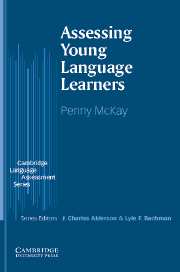Book contents
- Frontmatter
- Contents
- Series editors' preface
- Acknowledgments
- 1 A special case for young learner language assessment
- 2 Young learners and language learning
- 3 Research into the assessment of young language learners
- 4 Assessing language use through tasks
- 5 Classroom assessment of language use
- 6 Assessing oral language
- 7 Assessing reading and writing
- 8 Evaluating young learners' performance and progress
- 9 Testing young language learners through large-scale tests
- 10 The way forward
- References
- Index
- Publishers' acknowledgments
4 - Assessing language use through tasks
Published online by Cambridge University Press: 04 May 2010
- Frontmatter
- Contents
- Series editors' preface
- Acknowledgments
- 1 A special case for young learner language assessment
- 2 Young learners and language learning
- 3 Research into the assessment of young language learners
- 4 Assessing language use through tasks
- 5 Classroom assessment of language use
- 6 Assessing oral language
- 7 Assessing reading and writing
- 8 Evaluating young learners' performance and progress
- 9 Testing young language learners through large-scale tests
- 10 The way forward
- References
- Index
- Publishers' acknowledgments
Summary
The primary aspiration in language teaching programmes, for most parents and teachers, is that their children will become effective language users, that is, they will be able to communicate in the target language. When children are language users they are able to use the target language to exchange meaning in ways appropriate for the purpose and context. This may happen when they are interacting orally with their teachers, their peers in the classroom or others outside school, or when they are listening to and understanding their teacher talk, and when they are listening to stories or viewing videos. Language use takes place when children are reading stories and information texts and understanding the events, ideas and information in what they read. When children are producing their own writing in the target language, however simple the writing may be, they are using language.
In some teaching situations where external testing exists, parents and teachers also hope that their children will pass the required tests. Most parents and teachers would expect that tests promote their children's ability to use the language, though this is not always the case. Since external language tests can influence strongly the nature of language teaching and learning in the classroom, the alignment of formal tests with language use is highly desirable, as I discuss further in Chapter 9. Language educators can ensure that children learn to become language users by giving them the kinds of learning opportunities and conditions I described in Chapter 2.
- Type
- Chapter
- Information
- Assessing Young Language Learners , pp. 97 - 139Publisher: Cambridge University PressPrint publication year: 2005



